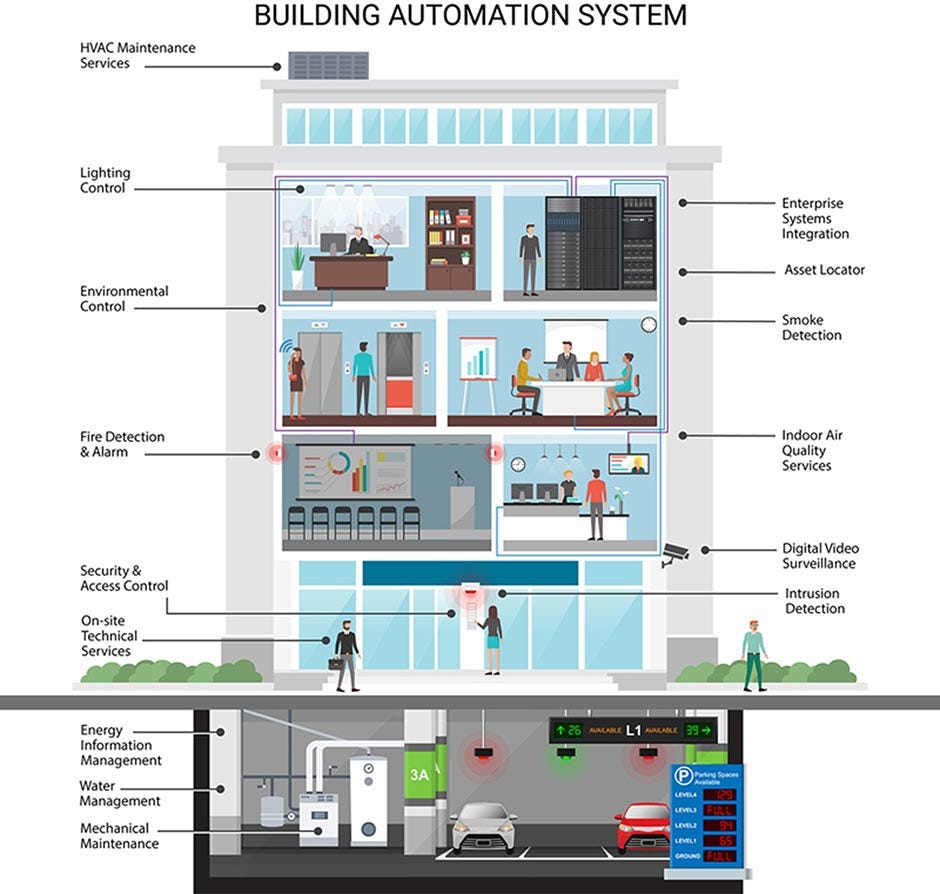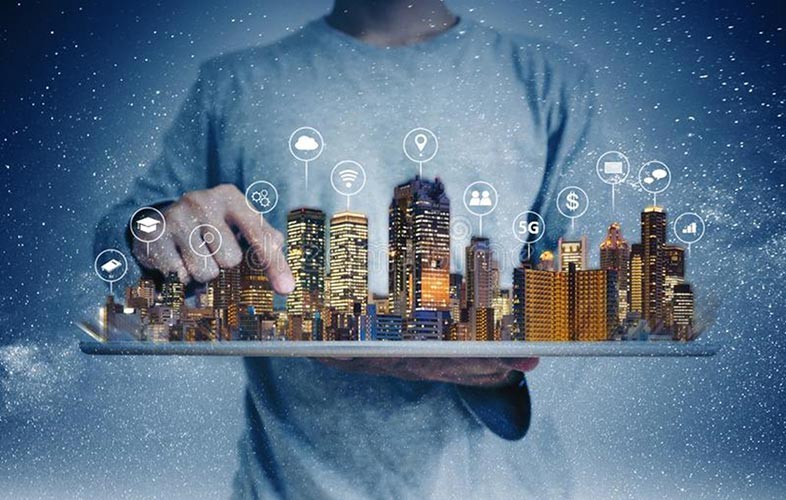Written by Habiba Yeasmin, Evbex
From Smart and Intelligent Buildings to the IoT, facilities management provides the glue that brings it all together for building and workplace optimisation — a layman’s guide.’
Smart buildings go far beyond saving energy and contributing to sustainability goals. They extend capital equipment life and impact the security and safety of all resources — both human and capital. They enable innovation by creating a platform for accessible information. They are a key component of a future where information technology and human ingenuity combine to produce the robust, low-carbon economy envisioned for the future. Intelligent buildings will use machine learning and artificial intelligence to proactively support occupants by learning from these inputs and enabling decisions that will benefit users.
This article provides a concise overview on everything that’s ‘smart’ and ‘intelligent’ within our buildings today. This offers a vast array of opportunity for facilities managers to do what they do best in creating efficiencies, cost savings and provide the basis for informed decisions to be made, based on accurate data.
Introduction
The ongoing Fourth Industrial Revolution has instigated the use of large-scale machine-to-machine (M2M) and modern smart technology (IoT etc.) for increased automation, improved communication and self-monitoring, and the production of smart machines that can analyse and diagnose issues without the need for human intervention.
Now, with decreasing physical human intervention, the discussions around ‘Smart buildings’, ‘Intelligent systems’ and ‘IoT-based industrial solutions’ have increased dramatically in recent years, and for good reason — competition. Buildings are being forced to look at all aspects of their design — management, amenities and operations — to be more attractive to owners and occupants than their competitors. At the same time, market pressure from consumers is forcing buildings to keep up with the rapid pace of innovation. Hence the move to smart or intelligent buildings.
In this digital age, all ‘smart’ devices have practically emerged just from being cool new gadgets to essential tools for conducting business. Now, temperature and lighting controls have gone from being thermostats and switches on the walls to Wi-Fi controlled from a mobile application, the prevalence of big data in decision-making processes and Internet of Things (IoT)- based solutions, all have become quite common. They have entered the commercial building market, performing controlling and monitoring operations and are ripe for data extraction and analytics.
What are smart buildings?
A smart building can be considered as one that is using technology to share information about what goes on in the building between systems so as to optimise the building’s performance. This information is then used to automate processes, including heating, ventilation, air conditioning, lighting and security and access control systems.
In parallel with creating operational efficiencies of the various building systems a key benefit of smart buildings is to optimise the use of energy and resources, both to cut cost and to improve energy efficiency.
The main features of smart buildings
Connected Systems — The most fundamental feature of a smart building is that the core systems within it are linked. The term ‘smart’ is usually considered as the ability of similar and different systems to talk to one another.
Sensors — Sensors are an integral part of smart buildings and play an important role in collecting data to inform decisions about where to allocate resources. For example, footfall counters may be integrated into the building to provide information on where people are at certain times of the day and which areas are high traffic.
Automation — Information is continuously gathered and analysed by building systems within a smart building. This ongoing monitoring allows for automated adjustments that can control conditions across an entire building at appropriate times of the day and on a seasonal basis.
Data — Smart buildings generate a large volume of valuable data which serves to continually improve controls and outputs and of course enables both operational staff and senior management to make key and timely decisions.
For a building to be considered ‘smart’, it should use technology to deliver useful, consistent, user-focused experiences as well as space and energy efficiencies.
A smart device or system uses IoT-based microprocessors and devices, are programmable to execute a pre-defined set of actions or sequence of operations and communicates with external systems via a computer network. The intricate collection of such devices and systems constitutes a smart building — it monitors various building characteristics, analyses the data and generate insights around usage patterns and trends that can be used to optimise the building’s environment and operations.
While smart technology provides greater control within your building, smart building technology allows you to manage and control operations, they are much more than just advanced ‘connected’ buildings.
Is it being ‘smart’ or simply being ‘connected’?
The word smart is increasingly being used to generally act as a user-friendly way of presenting the IoT to the general public. But being used as a catch-all term for a huge range of goods and services has led to uncertainty over what ‘smart’ actually means and is much more than just ‘command and control’ systems.
Connected
Connected buildings tend to feature technologies that have been plugged together, often for the benefit of owners and operators instead of the occupants — think lights that automatically turn off after 60 seconds when movement hasn’t been sensed, to save power, thus plunging people into darkness and resulting in the inevitable arm waving and star jumps to restore functionality.
Smart
In contrast, smart buildings are centred around the needs of the users, with consultants and Main Technology Contractors frequently being involved in the design stage of a project by seeking to understand exactly who will be using the building and what they’ll be doing in it. The services will be designed in reference to the user — by mapping out their day-to-day journey with any pain points established, allowing the design team to understand where technology can help to eliminate the issues — or even better, enhance people’s experience.
Smart buildings take a more integrated approach by considering the bigger picture — what people are trying to achieve within the building — and working downwards so that each device and system is considered. This results in more useful outcomes, such as personalising a user’s experience so that they can be more productive, or managing room temperatures more holistically by responding to the position of the sun and the weather that day rather than simply turning off the heating simply because the summer has arrived.
The level of integration is often a key point of difference between connected and smart buildings.
Intelligent Buildings
At the other end of the scale, we have ‘intelligent’ buildings, something we are increasingly able to achieve by inculcating technology that’s able to do even more to support occupants.
Though an exact definition has not been agreed upon, it tends to exercise the use of machine learning and artificial intelligence as the line between smart and intelligent.
Intelligent buildings will use machine learning and AI to proactively support occupants by learning from these inputs and making decisions that will benefit users. This continuous cycle of learning, responding to feedback, and optimising will theoretically make intelligent buildings capable of looking after themselves as well as their occupants.
The technology stack used in the creation of smart buildings is significant. Since many of the common smart building technologies tend to overlap with or frequently interact with one another, it’s important to distinguish them individually since each provides a distinct layer of functionality.
1. IoT at the Core of Smart Buildings Trends
Significantly, IoT has the capacity of solving real, everyday problems. It delivers practical results needed by your enterprise. Perhaps the most important and widespread smart building technology, the IoT is a system that uses a common Internet Protocol (IP) platform to connect multiple devices (such as sensors or microchips) to exchange and analyse information, optimizing each device’s controls automatically. When aggregated across an entire building, IoT allows for asset digitization throughout — and, therefore, immediate efficiency improvements.
IoT can leverage inexpensive wireless devices that can retrofit an existing building to monitor and control critical systems (e.g., HVAC). Certainly, retrofit IoT installations incur a fraction of the cost of installing or replacing an existing Building Automation System (BAS).
2. Artificial Intelligence and Machine Learning
Artificial Intelligence (AI), like IoT, is a buzzword that’s been getting quite a bit of attention lately but is frequently misunderstood. AI is the process by which machines or software mimic human behaviour and intelligence, with an ability to both acquire and apply knowledge. This allows for automation (basically, decision-making) within the machine or software without human intervention. Machine Learning (ML), often confused as a synonym for AI, is, in fact, a technique for realizing AI: It refers to the process by which a machine acquires knowledge or skill.
The applications of AI within smart buildings are extensive, especially being that AI is easily integrated with IoT sensors and devices. Such devices apply deep learning to hierarchically understand objects and environments, making adjustments according to learned user preferences or an analysis of historical trends.
For example, an AI and IoT-enabled asset management system will pick up on abnormalities in asset functioning — like a leaking refrigerator — based on what it has “learned” about the machine’s energy intake or output when functioning normally. AI-enabled Service Automation software then predicts upcoming maintenance and even reviews and approves work orders with minimal human intervention.
3. Software-Defined Networking and Cloud Computing
Software-defined Networking and Cloud computing offers virtualized platforms with flexible networking, compute, and storage services. SDN and Cloud platforms are generally run as a service based on big data centres and enable additional computational and storage capacity when needed. Cloud computing can eliminate on-premise infrastructure requirements and make networking and computing flexible from an enterprise perspective.
4. Aerial Drones
Drones are used to provide intelligent support within a building or retail space. They can handle many routine or time-consuming tasks, and may also use AI for autonomous operation such as facial recognition, surveillance, pre-programmed response, surveys, photography, routine tasks, capture data, video, and photos in hard to reach locations.
In advanced-level applications, drones can perform surveys for office space, retail facility, or even a grocery store by searching shelves for expired products. They can provide security surveillance and act on AI-based triggers, such as gunshot detection, and act as an additional set of simply manoeuvrable “eyes & ears” that sense minute details and work at all hours of the day.
5. Building Automation

Building Automation is a comprehensive infrastructure that permits centralized control of the HVAC, lighting, security, and other systems in a building. Building Automation is managed by either the Building Management System (BMS) or the Building Automation System (BAS). These systems are also compatible with IoT solutions and can monitor and control essential factors such as temperature, humidity, electricity, water pressure etc.
AI and IoT coupled with BAS make intelligent decisions to provide efficient and cost-effective operations.
6. Building Information Modelling (BIM)
Building Information Modelling (BIM) is a smart 3D model-based method that records and displays a facility’s physical and functional characteristics. Historically, AEC (architecture, engineering, and construction) professionals mainly used BIM, but it has become increasingly more prevalent within the context of facilities management.
A highly practical tool for both building maintenance and continuing use, BIM acts as a building “handbook” of sorts that provides access to real-time asset profiles as well as increased knowledge of asset locations.
This visual and spatial knowledge is astonishingly useful when restoring or renovating buildings. For example, BIM can tell where precisely a specific electrical circuit or equipment component is located behind a wall. Beyond geographic knowledge, it also offers insights into spatial knowledge, light analysis, and building component quantities and properties.
Additionally, BIM enables endless test situations without ever having to touch the space physically, which means reduced downtime and reduced labour spending.
7. Augmented Reality (AR)
Augmented Reality (AR) is a live, copied view of a real-world environment with computer-generated sensory input complementing its elements. It requires a camera and a display device like a laptop, smartphone, or even eyeglasses; expanded reality superimposes an imaginary object onto a view of one’s actual, physical environment.
The AR technology is incredibly helpful for facility management when used in combination with BIM.
Programmed with current BIM models, the glasses enable displays of “hovering” digital representations over each piece of equipment, offering recognition and additional information. Such knowledge may include written instructions, alerts, installation dates, and problem-solving, all of which are particularly useful during outages or emergencies.
8. Virtual Reality
Virtual reality (VR) goes a step further with computer-generated sensor input providing a full immersion experience by blocking out the physical world and putting the user into a realistic, virtual environment. The design and construction industries have adopted VR as a useful tool during the mockup phase.
VR-powered mockups enable a customer to view a potential building as if visiting the space. The customer may walk around, inspect windows and staircases, and get a sense of the constructed structure’s layout and function before any work has begun.
While virtual reality within the facility management industry is still far from widespread, the technology has started to become more powerful and affordable in recent years. But it can be integrated into applications for facilities management and used for repair and upkeep.
Benefits
- Asset Digitisation
IoT facilitates asset digitization at the whole building or individual asset level. IoT can capture granular data from those critical HVAC assets in the building, including supply/return temperatures, fan speeds, vibration, flow rates, compressor run times, total energy consumption, etc. All of these measures can be captured in real-time to enable key operational insights (e.g., AI). Critically, IoT connects you to key assets in a building. When aggregated across the entire building, IoT delivers asset digitization across the entire building.
- Energy Efficiency and Indoor Air Quality Monitoring
IoT will continue to produce outsized results in the quest for energy efficiency because market penetration has only just begun. An alarmingly low percentage of buildings today have access to any form of real-time energy reporting. Too many buildings continue to rely on manual meter reading.
IoT provides the fastest, most economical method of augmenting your building’s infrastructure to enable real-time IAQ monitoring. Even the most advanced BAS will barely support modern IAQ measures such as Particulate Matter (PM) and Volatile Organic Compounds (VOCs).
- Workspace/Workforce Management
IoT sensors have made increasing amounts of data available to understand how occupants use the space. For example, wireless lighting control systems can embed occupancy sensors in lighting fixtures to gain a granular understanding of workspace usage. Reconfiguring space based on employee usage shows much promise in minimizing lease costs, while also increasing employee productivity and tenant satisfaction. Thus, the savings potential goes way beyond the usage of IoT for energy savings.
How can smart technology help Facilities Managers?
By predicting potential issues
Monitoring and maintaining the different systems within a building is time-intensive and many facilities managers find themselves trapped in a reactive role, responding to things when they go wrong or dealing with complaints, with no time for forwarding planning. Smart technology allows you to take a much more predictive, proactive role as you have a clear picture of everything that’s happening across all your buildings or spaces at any one time.
By reducing administrative work
Smart sensors gather a wealth of data which, when plugged into the internet or ‘cloud’, can be displayed in various formats, helping you to see what’s important to you. This work is all done for you, saving the effort of producing reports by hand. Cloud platforms can transform your data into easy-to-read dashboard or reports, making it easy to benchmark and spot potential trends. This clearer, overall picture helps to reduce siloed ways of working.
By helping you comply with industry standards
Using smart sensors to monitor the performance of your buildings and machinery makes compliance with industry standards far easier. The data they produce enables you to spot potential problems before they occur and can also help to minimise things like energy use.
Smart Buildings connecting to an Intelligent Future
Smart buildings go far beyond saving energy and contributing to sustainability goals. They extend capital equipment life and also impact the security and safety of all resources — both human and capital. They enable innovation by creating a platform for accessible information. They are a key component of a future where information technology and human ingenuity combine to produce the robust, low-carbon economy envisioned for the future.
In the long run, smart buildings will play an essential role in our sustainable efforts, our relationship with our working environments and with one another. We will continue to have more smart buildings, whilst existing smart buildings will get even smarter, and advances in technology will continue to push the capabilities of our surrounding built environment.
Exactly what this will look like in the long-term, no one can be certain, but one thing is for sure: smart buildings will play an essential role in the development of our future.
For More Information:
- info@evbex.com
- www.evbex.com


